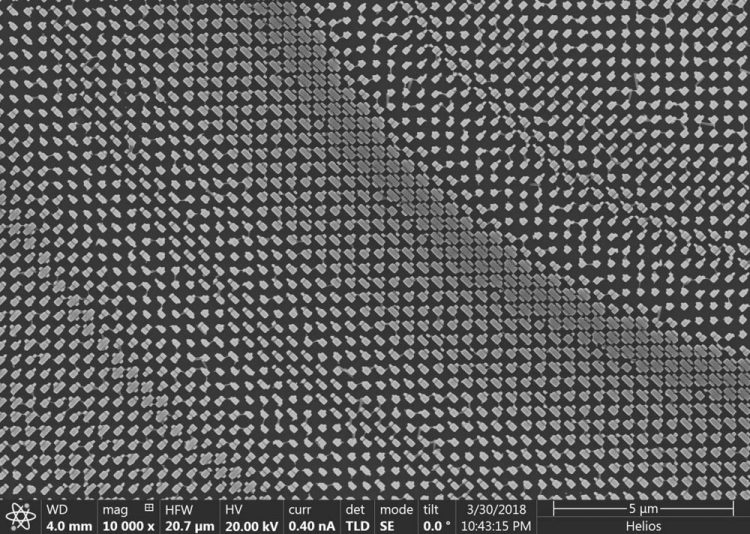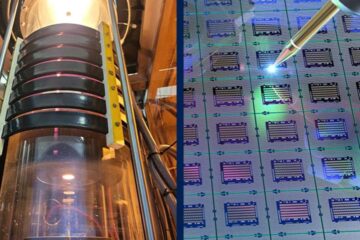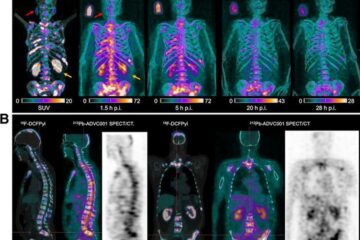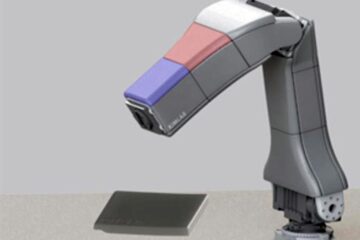Broadband achromatic metalens focuses light regardless of polarization

These newly designed nano-structures on the surface of a metalens can focus light regardless of its polarization, doubling the efficiency of the lens. Credit: Capasso Lab/Harvard SEAS
We live in a polarized world. No, we aren't talking about politics — we're talking about light. Much of the light we see and use is partially polarized, meaning its electric field vibrates in specific directions.
Lenses designed to work across a range of applications, from phone cameras to microscopes and sensors, need to be able to focus light regardless of its polarization.
Researchers believed that symmetric nanostructures such as circular pillars were essential building blocks to develop photonic devices that are not sensitive to polarization.
Now, researchers from the Harvard John A. Paulson School of Engineering and Applied Sciences (SEAS) have developed a polarization-insensitive metalens comprised of non-symmetric nanofins that can achromatically focus light across the visible spectrum without aberrations.
This flat lens could be used for everything from virtual or augmented reality headsets to microscopy, lithography, sensors, and displays.
“By making this lens polarization insensitive, we have doubled the efficiency of the metalens from previous iterations,” said Wei Ting Chen, a research associate at SEAS and first author of the paper. “This is the first paper that demonstrates both achromatic and polarization insensitive focusing in the visible spectrum.”
The research was led by Federico Capasso, the Robert L. Wallace Professor of Applied Physics and Vinton Hayes Senior Research Fellow in Electrical Engineering at SEAS, and published in Nature Communications.
In previous research, Capasso, Chen and their team demonstrated that arrays of titanium dioxide nanofins could equally focus wavelengths of light and eliminate chromatic aberration, but those lenses could only focus a circularly polarized light.
“This meant we were essentially discarding half of the incident light which does not possess the right polarization,” said Alexander Zhu, co-author of the study and graduate student at SEAS.
In this latest design, the researchers changed the layout of the nanofins, positioning each pillar so that it is either parallel or perpendicular to its neighbor.
“This new design gives us a lot of freedom to tune the geometrical parameters of the metalens, which allows us to better achieve achromatic focusing across the entire visible range,” said Chen.
“Next we aim to maximize efficiency and make much larger-size achromatic metalenses to bring them into everyday life for a wide range of applications,” said Capasso
Harvard's Office of Technology Development has protected the intellectual property relating to this project and is exploring commercialization opportunities.
###
This research was co-authored by Jared Sisler, and Zameer Bharwani. It was supported by the Air Force Office of Scientific Research and the Defense Advanced Research Projects Agency.
Media Contact
More Information:
http://dx.doi.org/10.1038/s41467-019-08305-yAll latest news from the category: Physics and Astronomy
This area deals with the fundamental laws and building blocks of nature and how they interact, the properties and the behavior of matter, and research into space and time and their structures.
innovations-report provides in-depth reports and articles on subjects such as astrophysics, laser technologies, nuclear, quantum, particle and solid-state physics, nanotechnologies, planetary research and findings (Mars, Venus) and developments related to the Hubble Telescope.
Newest articles

Silicon Carbide Innovation Alliance to drive industrial-scale semiconductor work
Known for its ability to withstand extreme environments and high voltages, silicon carbide (SiC) is a semiconducting material made up of silicon and carbon atoms arranged into crystals that is…

New SPECT/CT technique shows impressive biomarker identification
…offers increased access for prostate cancer patients. A novel SPECT/CT acquisition method can accurately detect radiopharmaceutical biodistribution in a convenient manner for prostate cancer patients, opening the door for more…

How 3D printers can give robots a soft touch
Soft skin coverings and touch sensors have emerged as a promising feature for robots that are both safer and more intuitive for human interaction, but they are expensive and difficult…





















